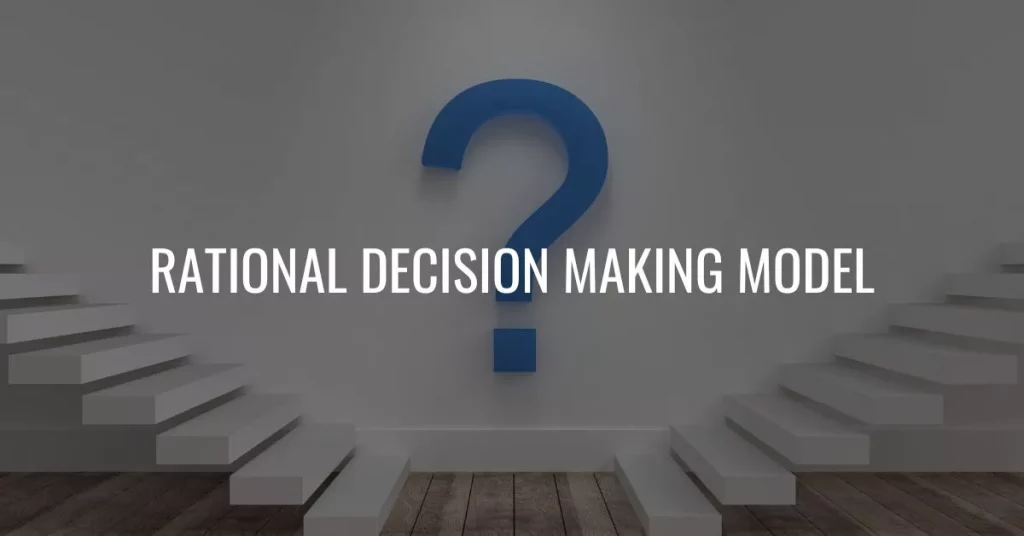Rational Decision Making Model
All managers face issues every day that need decisions; decisions about managing employees, and resources, and setting plans and strategies. And to do that, there are two ways to make a decision, the Intuitive way and the rational decision-making way.
In the last article (Effective decision making) we’ve discussed how to make Effective decisions, and in this article, we’ll discuss how to make rational decisions.
Amazon Recommended book: The Decision Book: 50 Models for Strategic Thinking

Rational decision-making model definition:
Rational decision-making is a multi-step and linear process, designed for problem-solving starting from problem identification through solutions, for making logically sound decisions.
The rational decision-making model is a good model to make good decisions because it depends on the rational way used for problem-solving.
Rational decision-making model steps:
If you want to make a good decision that helps you to achieve your goals; you should depend on the available facts to make a careful analysis to make a decision as we’ll explain in the following steps:
Step 1: Identify and define the problem:
The first step to making a rational decision is to identify and describe the problem by defining the current and desired states and defining the alternatives:
- Keep in mind during identifying the problem to identify the cause of the problem, not the symptoms.
- Define the gap between the current state and the desired state. And the gap must be enough to motivate the involved people to implement the decision.
- Define all available options and don’t think about quick solutions.
For example: if your family is growing and you have a small house that doesn’t meet your needs. Let’s assume that your decision is buying a bigger house to overcome that issue.
Note that: buying a new house is a solution (not identifying the problem), and in this way you don’t think about the cause of the problem (space), the gap between the current and desired state, and all alternative options.
The cause of the problem:
Buying a new house isn’t a problem, it’s a symptom. And the cause of the problem is (Space).
The gap between the current and desired state:
In our example, you should mention the available space and the needed space.
All alternative options
Think about all alternatives:
- If there is unneeded stuff in your house can be removed to free up space.
- Having a space to build a new room in the house.
- Buying a new house.
Step 2: Identify the decision criteria:
The second step in the rational decision-making model is outlining all the criteria ahead of time because those criteria will be a good guide to making a decision
Example: let’s get back to our problem, space is our issue and we need to identify some criteria to measure all alternatives and determine if there is a solution that is better than others, in this example our criteria are (time and cost)
Time: we should think about:
- When will we need that space?
- When will solving the problem be critical?
- And how long will each option take?
Cost: these criteria are important to know if there are some options cost more than others; so you should know:
- How much will each option cost?
- How much money do we have?
Note that: if our problem is buying a new house instead of solving a space issue, we would establish criteria a little differently; and we would likely focus on things like distances to activities, crime per capita, quality of schools, and some other factors.
Now we’ve identified the problem and the decision’s criteria, it’s the time to weigh those criteria:
Step3: weight established criteria:
We need to weigh those criteria because each criterion is unlikely to have the same level of importance; there are a few ways you can use to accomplish this step:
1- Using an absolute comparison:
You can use this method which you commonly find costumers’ ratings; this comparison is helpful because it allows you to compare items side by side. So if you’re shopping for a product, you can look through customers’ reports and ratings and compare different types of the product in a specific category.
Those reports and ratings are accomplished by incorporating a ranking system where the user enters a value reflecting the importance of the criteria on a scale.
For example: let’s say that there is a scale starting from “1” and going to “10”. “1” indicates that the criteria have no importance to us and a score of “10” indicates that the item is very important. So we would go through each criterion and use this method to weigh their significance to us.
Since we are evaluating the criteria on their own metric and not in relation to another criterion so we can assign the same value to different criteria.
2- Using relative comparison
Relative comparison is made by comparing each criterion with another. So by using relative comparison; we can obtain what criteria are most important to us. This can be helpful when you attempt to weigh criteria that have similar ratings by using an absolute comparison.
So by comparing them against one another we firmly know which one is more important.
Step 4: Generate a list of alternatives
Once we have identified a thorough list of criteria and weighed the importance of those criteria, now we can generate a list of alternatives.
During this step, our goal is generating many alternatives as possible. The more alternatives that we generate, the greater the likelihood is that we’ll come up with an effective solution to our problem.
Going back to our problem, we can generate a few alternatives, including buying a new house, building another room, placing possessions in storage, or even placing a few kids up for adoption.
Keep in mind, in this stage we define all possible options, no matter whether they are good or bad solutions because we’ll think about that in the next stage.
Step 5: Evaluate the alternatives:
At this stage, we want to evaluate the alternatives that we’ve identified using the criteria that we’ve identified in step2. This step may be lengthy depending on the number of criteria and the number of alternatives.
Let’s go back to our Example: we’ll use a simple rank-order method to rank the alternatives in the criteria that we’ve identified. We’re also establishing weights for each criterion based on our findings from step 3. as shown in the following table:
| Long term-solution (0.6) | Time (0.3) | Cost (0.1) | |
|---|---|---|---|
| Buying a new house | 1 | 4 | 4 |
| Placing possessions in storage | 4 | 1 | 1 |
| Increase the size of home | 2 | 3 | 2 |
| Reduce family size | 3 | 2 | 3 |
Step 6: Determining the optimal decision
The sixth step in our rational decision-making model is determining the optimal decision. In order to know the optimal decision, we’re going to multiply the ranking for each alternative by that criteria’s respective weight.
| Long term-solution (0.6) | Time (0.3) | Cost (0.1) | Total | |
|---|---|---|---|---|
| Buying a new house | 1*0.6 = 0.6 | 4*0.3 = 1.2 | 4*0.1 = 0.4 | 0.6+1.2+0.4=2.2 |
| Placing possessions in storage | 4*0.6 = 2.4 | 1*0.3 = 0.3 | 1*0.1 = 0.1 | 2.8 |
| Increase size of home | 2*0.6 = 1.2 | 3*0.3 = 0.9 | 2*0.1 = 0.2 | 2.5 |
| Reduce family size | 3*0.6 = 1.8 | 2*0.3 = 0.6 | 3*0.1 = 0.3 | 2.7 |
Since each criterion has a different level of importance, we use these levels to assign more influence to the results in categories that have more importance.
And since we’ve already weighed the established criteria in step 3, we know exactly which criteria to give more importance to as we determine the optimal decision. As you can see, buying a new house appears to be the best solution based on the evaluation.
As we end I want to leave you with a word of caution. Models, by their very nature, are clear, organized, and logical. Everything in the real world is not. So applying a model to an environment isn’t perfect but it’s a difficult task.
It is true that statistically, those who use such a model will make more rational decisions, whether in their business or in their personal lives. But money, time, and other constraints can affect a manager’s ability to use such a model as it was intended; because maybe you can’t evaluate every alternative and identify every possible option. But if your goal as a manager is to make more rational decisions, this is certainly a start.

Patrick is a lifelong learner and personal development blogger whose work focuses on mindset shifts, emotional growth, and the hard-won lessons from real-life challenges.
Qualities: Relatable, honest, introspective, growth-oriented.
